|
|

with photos by Andrew Easton
Late March 1997 saw Ricky Fairhead, Andrew Easton and I hurl away our winter woollies in favour of summer attire when we visited Israel. A late package deal two weeks before the off took us to Eilat on the southern tip of the country where for seven days our bare parts were paraded for all to see in glorious sunshine (arms and legs only!). Eilat is similar to many coastal Mediterranean resorts, but is slightly smaller with many more birds! Its situation at the northern tip of the Red Sea is at a junction point for thousands of birds moving from southern wintering grounds in Africa north into Europe and the Middle East and produces some five-star Arabian specialities - ideal ingredients for an impressive trip list.
March
17
While boarding the coach at Ovda for the short 50-minute journey to Eilat
we noted our first birds of the trip Yellow-vented Bulbul, Brown-necked Raven
and a House Sparrow. Once in Eilat it was raining which was surprising as
the area had only received 9% of the expected rainfall in recent months. Two
House Crows were seen flying towards Petra in Jordan where the majority of
the population roosts. Early in the evening we met Lee Evans who told us a
Black Bush Chat had been found in the Park and the Grey Hypocolius was still
present at K-20 (We’d found out about the Hypocolius prior to us leaving).
That evening we kept our fingers crossed hoping both would still be there
tomorrow.
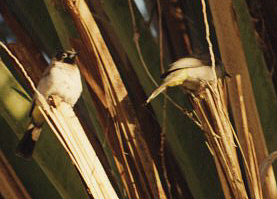 Yellow-vented
Bulbuls.
Yellow-vented
Bulbuls.
March 18
The first birding proper of the holiday was in the Shulamit Park. A couple
of Spanish Sparrows were seen with numerous House Sparrows and a Laughing
Dove was seen on top of a lamppost. A bird disappeared over an embankment
appeared to have a long black tail. Yes, it was the Black Bush Chat. Amazingly
only the third Ave of the day, the bird gave excellent views but was very
mobile and disappeared for short periods before turning up in another area
of the park. Other species seen included Woodchat Shrike, Olivaceous Warbler,
House Crow, Pied Wagtail, Swallow, Wryneck, Hoopoe, Lesser Whitethroat and
Sparrowhawk.
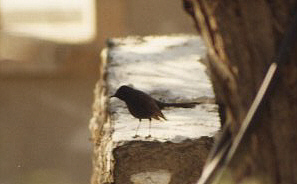 Black
Bush Robin.
Black
Bush Robin.
A second Laughing Dove was seen on the beach. At the campsite two stunning male and one female Greater Sand Plover graced the shoreline. A Kentish Plover fed close by, while a few Little Egret were seen flying around the fish farm. Slender-billed Gulls were the commoner gull seen with Black-headed Gull second. A first-year Great Black-headed Gull flew over briefly and more familiar species included Sandwich Tern, loads of Grey Heron, Cormorant and Lesser Black-backed Gull. A walk along the canal produced Kingfisher, Collared Dove and three Graceful Warblers.
Lying adjacent to the beach is the New Lagoon, where the irrigation system attracted copious insects, which proved popular with pipits. Here one of two wintering Buff-bellied Pipits was seen with the Water and Red-throated. The Buff-bellied Pipits that occur in Israel are of the eastern form A. r. japonicus a recent split from the American form rubescens. Somewhat surprisingly was the ease with which we identified it. Even at distance it could be picked it out easily, as it was the only pipit with a ring! Other species here included Kentish and Little Ringed Plover, House and Spanish Sparrow, White Wagtail, Ringed Plover and the proverbial Redshank. On the way back for breakfast we noted Rock Martin and Tristram’s Grackle a large starling with conspicuous orange bases to the primaries, very good value indeed.
At the
park we didn’t pay to much attention to the Hoopoe and Bluethroats present
as we learned of the Hypocolius’ presence. Being only the ninth for the Western
Palearctic this was obviously a priority bird so we wasted no time arranging
car hire. While waiting at the car hire centre a few raptors were passing
overhead albeit very high. Frustration came in the form of an eagle that was
probably Imperial but was too far away to be certain, in other words stringy.
Somewhat closer was our first Palestine Sunbird of the trip, a cracking male.
This little stunner is also referred to as Orange-tufted Sunbird, a feature
that the males exhibit when displaying. Their characteristic ‘chewi-chi-chi-chi-chi-chi’
calls indicated their presence at many localities throughout the rest of our
stay. In the park four Tristram’s Grackle, Steppe Buzzard and Black Kite were
seen along with numerous Chiffchaff, Blackcap and Reed Warbler.
We arrived at K-20 mid-morning by which time it was already very hot. Despite this, one hard core birder (British of course) stood dressed appropriately, in a wax jacket! He pointed us in the direction of large acacia that the Hypocolius was embedded. Sure enough after about 10 minutes the shrike-type bird appeared, although was amazingly difficult to see. It gave infrequent appearances like this for the next half-hour before flying towards a farm building, briefly perching in full view before promptly disappearing. Luckily this bird was a male being much more interesting to look at than the females. We arrived shortly after some Dutch birders had departed who were day twitching the Hypocolius. It may seem extreme and quite possibly is but it probably only cost a fraction more than a dodgy STARLING on Scilly and with a supporting cast of Steppe Eagle, Slender-billed Gull, Red-rumped Swallow, Sardinian Warbler, Woodchat Shrike, Little Green Bee-eater, Bluethroat, etc all seen was slightly better value for money.
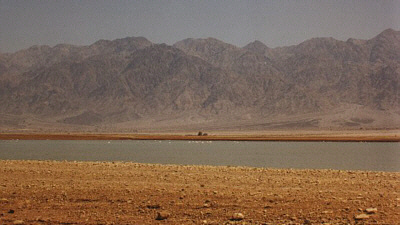 View
across reservoirs at K20 with Jordan in the background.
View
across reservoirs at K20 with Jordan in the background.
A Black-eared Wheatear appeared briefly a few moments before a large bulky Sylvia warbler was found. Once in full view it proved to be Orphean Warbler, either a female or 1st year male. On nearby desalination lakes a number of waders were seen including 10 Black Winged Stilt, 4 Little Stint, Greenshank, Redshank, Ruff, Wood, Green and Marsh Sandpipers. A large flock of duck were predominantly Garganey with a few Teal and Shoveler. Although pretty inactive in the mid-day heat 34 Greater Flamingo were still a nice sight.
An untimely
roadside stop due to the boot of the car opening near K-34 produced a boring
Brown-necked Raven and a couple of bit less boring Crested Lark. At K-33 a
Northern Wheatear was as exciting as it got so we didn’t linger. Hard times!
At K-40 the sight (not smell) of a steaming pile of dung proved irresistible
and we went in armed with a clothes peg for a closer look. Usually these heaps
are a magnet to larks but unfortunately on this occasion two Red-throated
Pipits and a single Short toed Lark were all we could muster, shit hay! A
Stone Curlew was heard and two swifts flew past which with hindsight were
blatant Pallid. A pair of Little Green Bee-eaters gave superlative views,
absolutely stunning birds. The sewage works hosted a pair of Spur-winged Plover
and two Wood Sandpipers. The run off from the pools produced a stream with
a mini delta surrounded by reed. Here one of my personal favourites was seen,
Dead Sea Sparrow. A flock of 50 included a few Spanish Sparrows. Male Dead
Sea Sparrow must surely be the best sparrow you’re likely to see and are everything
you expect them to be, dead smart. Other birds here were Crested Lark, Northern
Wheatear, two White Stork, Marsh Harrier, Brown necked Raven, Water Pipit,
Bluethroat, Snipe, Graceful Warbler, Black-headed Wagtail, Sparrowhawk and
Hoopoe. A trail of diagnostic impressions in the sand indicated that a Houbara
Bustard had wandered through recently. Bustard by name, bustard by nature!
A 1st summer Mediterranean Gull seen from the campsite proved to be the only one of the trip and was the rarity amongst the forty or so Slender-billed Gulls. Pride of place went to the 30 resplendent White-eyed Gulls that were seen milling around close inshore one of the best birds I’ve seen. This species is a very hit and miss Red Sea speciality so we considered ourselves very fortunate to see such a large gathering. A gentle southerly wind no doubt contributed to this figure encouraging them north up the Gulf of Aquaba. Just as stunning and slightly closer were the three Greater Sand Plover on the shoreline. The first Western Reef Heron of the trip was on the tide line of Jordan. Another Red Sea star was a rather uninspiring Brown Booby on a very distant buoy, it was literally off the coast of Saudi Arabia.
Green Heron used to be easy to see next to the water shoot in the harbour but the demolition of this tourist attraction has seen them take up residence on the fish farms offshore. Subsequently they are difficult to pick out - we saw one.
March
19
The day started brightly at the New Lake with the usual: Little Egret, Bluethroat,
Hoopoe, Spanish Sparrow, Laughing Dove, Pied Wagtail and lots of Graceful
Warblers. The undoubted stars of the show were the pair of Pied Kingfisher
fishing on the lake. Two sensational Great Black-headed Gulls flew overhead
and Green Heron, Brown Booby, Citrine Wagtail, Water Pipit completed a pre-breakfast
stroll.
K-33 in appearance is as exciting as its name suggests but has many quality birds resident. Ideally you need to be there early morning before the temperatures rise and birding becomes somewhat uncomfortable. We bumped into a Canadian birder who said, “you should have been here last week”. Apparently most of the larks had been displaying the previous week and had paired up and therefore become more elusive. Unfortunately a wintering Dunn’s Lark had departed. However we soon managed to find a pair of obliging Bar-tailed Desert Larks. A Desert Warbler proved to be impossible to see in the tiniest bushes imaginable and was only seen as it zoomed from bush to bush. The star of the show was undoubtedly Hoopoe Lark. We heard this bird singing long before we saw it, but it’s definitely worth waiting for. If we had of sat in the car we would have been treated to superlative views as it ran over and alighted in the shadow of the car for some time, a great photographic opportunity if ever I’ve seen one Mr. Wincup! K33 produces quality not quantity.
Arabian Warbler was high on the wanted list and a trip north to Yotvata was necessary. The habitat here is arid being dominated by Acacia scrub. We soon found a stunning male Redstart, Hoopoe, Bluethroat and Little-green Bee-eaters. Overhead a pair of Egyptian Vultures drifted around in lethargic fashion and a flock of 1000 White Storks glided through a gap in the cloud. It didn’t take too long to find Arabian Warbler and when we did we had excellent views.
 Amram's
Pillars (lower middle left).
Amram's
Pillars (lower middle left).
The drive
up to Amran’s Pillars was a little turbulent to say the least and some skilful
driving and navigating was needed to avoid the boulders ahead. Luckily we
only managed to drive over one large bolder which sounded like it was going
to wreck the undercarriage of the car as we went over it. Once at the car
park we stared aimlessly into every nook and cranny in the facing rock in
search of our quarry species, Sinai Rosefinch. Just as some despondency
started to creep in a couple of birders who were with us spotted 29 Black
Stork flying over the gorge. They decided to go and see what the Pillars were
like leaving us to soak up the sun! During the wait a couple of Sand Partridge
ran across the path besides us and promptly disappeared, a habit most desert
birds have. The two birders returned saying the pillars weren’t to impressive
but the Hooded Wheatear was! We leapt into action and soon located the wheatear
singing high up on the ridge of the gorge. A group of 11 Black Stork spiralled
into view about the cliff edge and soon drifted over. Shortly after a much
larger and impressive group of 62 came over. These were still relatively distant
when Andrew alerted Rick and myself to an eagle with the storks, no reaction
(then voicing some concern) “this eagle is very dark”. The eagle came closer,
“this bird is almost black!” reaction, where the feck is it then? We eventually
got on it and the palpitations began as the bird lost a little height showing
clearly white patches at the base of the primaries, black underparts and when
it turned a white horseshoe on the mantle. Verreaux’s Eagle. A pair had taken
up semi-residence in the mountains and had been seen at various locations
so was always an outside chance but we as with every other birder in Israel
thought we had no chance. This bird left us jumping for joy. Further down
the track we found the site for the rosefinch. We soon saw two and both stunning
males. These birds are very hit and miss as they move up into the mountains
to breed around this period. Also present was a pair of stunning White-crowned
Black Wheatear along with a young bird complete with black crown (see Antique
Rarities – and get gripped severely).
 Sinai
Rosefinch and White-crowned Black Wheatear.
Sinai
Rosefinch and White-crowned Black Wheatear.
At the north fields fishponds a stunning male Citrine Wagtail posed briefly on a rock just in front of a Kentish Plover. Red-rumped Swallows were evident amongst the more common hirundines. Just as we were commenting on how poor the visual migration had been a large flock of spiralling storks were spotted in the distance a nice sight. However, it soon became apparent that we were watching different flocks. As we scanned around we noticed literally thousands and all were descending. Someone claimed a Black amongst them but it wasn’t worth looking for, a needle in a haystack job if ever I’d seen one. It was quite literally raining White Storks. It was estimated that around 15,000+ were in the air, quite breathtaking and by far the highlight of the trip. A cracking male Stonechat of therace/species variegata was seen being a classic individual with a brilliant white rap around rump and white bases to the tail sides. Two Bluethroat were flushed and a Black Kite and Short-toed Eagle were spotted amongst the fragmented mass of storks.
 White
Storks
White
Storks
The small pools at K-20 are aptly nicknamed the Crake pools and fortunately for us the namesakes had been present. Out of the three possible, Baillons was the only absentee. Although no one was complaining with two Spotted and three Little seen. As you’d expect they weren’t particularly easy despite the pool’s small size and took a little patience before good views were obtained. In the meantime Crested Lark, Kestrel, Greater Flamingo, Pochard, Pintail and male Dead Sea Sparrow were seen. The Little Crakes were definitely the more obliging and were seen on several occasions as they ventured out of the reeds onto the mud. The Spotted was only seen briefly by myself as it retreated into the reed, it had extensive spotting on the under parts, so made it into the notebook – just!
March
20
On yet another glorious morning we wandered up to a newly created habitat
called Switzerland Park at the north end of the salt pans. Here a Cattle Egret
fed on the trackside, not a common bird by any means in southern Israel. A
1st year Great Black-headed Gull flew over with a few other gulls and stood
out like a sore thumb. As the ground warmed, the previous evenings White Storks
funnelled upward trying to find the thermals. A familiar call led us too a
group of 22 Cranes heading low north. All were adults bar one. Here we were
led to our first and last Desert Finch of the trip by a birder who had left
his drivers licence at home. This was a cracking male but he still didn’t
get a lift. At the Jordanian border crossing two large raptors were seen flying
away as they came out of roost from a date palm plantation. The one that turned
allowed us (Rick and Andrew!) to identify it as Lesser-spotted Eagle. The
second bird was almost certainly the same species. We failed to find the Bimaculated
Lark at the border crossing but one Crested Lark was seen.
 Flock
of Common Cranes.
Flock
of Common Cranes.
One dung
heap I can certainly recommend is the one at K-20. Top of the poops was a
stunning male Cretzschmar’s Bunting along with an obvious Isabelline Wheatear
doing its best to obliterate the local fly population. The reservoirs held
49 Greater Flamingos and a Caspian Gull with good numbers of migrant
waders along the shores we couldn’t find the male Greater Sand Plover present
though. By now the Hypocolius had become more elusive and we dipped out but
male Sardinian and four Ruppell’s Warblers were ample compensation. Another
target species is Namaqua Dove and a leaking hose had attracted a couple.
Eventually we saw two females and were surprised at how small they were. To
be honest they’re not much to look at but are pleasantly unobtrusive. Alpine
Swift was something I wanted to see so when we had our first I got a little
excited.
Dom Palms is a recommended site for Scrub Warbler. These are a little like Graceful Warbler in shape but look different. We saw one of these plaintive wren like birds. This is a rather naff place so I shall not write any more about it, even a breeding pair of Woodchat Shrike looked bored.
At the pumping station Desert Lark, Rock Martin, Ruppell’s Warbler, Blackstart and White-crowned Black Wheatear were seen. The stars of the show here are Lichtenstein’s Sandgrouse. These birds come in to drink at the ‘dripping tap’ at dusk and this is the only reliable site where they’re guaranteed. Fortunately nineteen appeared while there was still plenty of light affording good views. The males are excellent birds and we had good views of several.
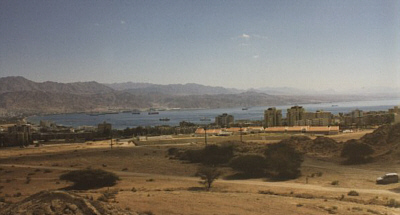
View from the pumping station overlooking Eilat, with Jordan on the opposite
side of the Gulf of Aqaba and Saudi Arabia off to the far right.
March
21
The car had to be back at 11:00 so to make the most of the morning we skipped
breakfast and headed north to Shizaffon sewage beds. On the way through the
mountains some Wacky Racer driving got us a puncture. This cost us half-hour
but at least I now know how to change a tyre, assuming I can find a large
rock! When we arrived we had mixed fortunes. Syrian Serins had been present
during recent weeks. Apparently the maximum count over that period had been
twenty-five, although numbers had dwindled to around five the previous day.
Unfortunately we dipped. A sandgrouse could be heard before myself and Andrew
saw it. Although I have to confess we didn’t identify it until mid-day back
at the hotel. We had both noted a dark belly patch characteristic of Spotted.
A Steppe Buzzard that was perched on a rock didn’t stay to long. The
highlight here had to be the wolf, which Andrew spotted as it trotted across
the desert heading for the road. It stopped for a few minutes as it must have
got a taste of our scent down wind (almost fainting in the process!) allowing
us to scope it. We alerted a couple of other birders present that duly saw
the wolf and told us we’d missed a Temminck’s Horned Lark. Another mammalian
tick was a desert race Fox that looks nothing like a normal Red Fox. Black-eared
Wheatear, Cretzschmar’s Bunting and Bluethroat were also seen.
On the way back we made the mistake of rushing back to the car hire centre subsequently missing numerous raptors that were seen coming out of roost from the date palm plantations just to the north of Yotvata. Most appeared to be Black Kites but a couple of Steppe Eagles were seen along with a Short-toed flying just above the car.
At mid-day the temperature soars as the sun gets overhead making the birding more difficult so we let the birds come to us for a change. Andrew and myself went for a dip (no we didn’t go back for the Serins) in the pool where I drowned my sorrows literally, I’m a naff swimmer but soon got rehydrated. Ricky opted to top his tan basking in the shade of a palm tree complete with Levi’s denim sun block. After our ‘relaxation’ we went out to do some birding. The date palms were nothing like I had anticipated. It was a bit of a disappointment to walk around in what can only be described as a dust bowl. They were certainly a far cry from the halcyon days of the early 90’s when they were irrigated and were a magnet for migrants. Our quarry species here was Indian Silverbill. This species was first recorded in Israel as recently as 1983 as a result of a marked expansion from its breeding grounds in eastern Arabia and the Indian sub-continent into west Arabia and neighbouring semi-desert areas. The expansion is attributed to escapees/introduced birds. Although there is probably evidence for this if Collared Doves can make it to Britain I’m sure Silverbills can make it to Eilat. We managed to see three of these unobtrusive species accompanying a flock of House Sparrow. To be honest they’re not much to look at being sandy in plumage with a white rump, black primaries and uppertail. The Silverbills were one of five species seen in the date palms the other three being Laughing Dove, House Crow and the not-to-be-knocked Dead Sea Sparrow.
 House
Crow.
House
Crow.
At the north beach the Brown Booby appeared as a distant brown blob on a buoy whilst White-eyed Gull numbers had decreased to nine. Four Western Reef Herons were spotted amongst a flock of Little Egrets heading inland, as were three Caspian Terns. The Great Black Headed Gulls continued to excite.
March
22
The Black Bush Chat was still pleasing newly arrived birders in the park although
like the Hypocolius had become slightly more elusive. A Sqaucco Heron was
the first new bird of the day for me. This was flushed from typical habitat,
the top of a lamppost. Two Kestrels were seen along with Bluethroat, Reed
Warbler, Olivaceous Warbler, Blue-headed Wagtail, Blackcap and a Sedge Warbler,
which fed in the open on a lawn all morning.
On the way to Wadi Sholomo we were quizzed by our taxi driver as to whether we were going to watch the naked women on the beach, Andrew was out voted and we proceeded up the wadi. We got talking to an old local chap, (or was it the other way round?) who made his feelings abundantly clear about Eilat’s development into a tourist resort declaring “Israel is big shit”. He then proceeded to moan about the erosion caused by the camel rides before speeding off on a quad bike! To be fair though he had a good point. Never mind if it weren’t for the camels dung we wouldn’t have seen Blackstart down to a few feet as they fed voraciously on the flies. Two large raptors appeared over head proving to be Bonnelli’s Eagle. These had taken up residence in the mountains south of Eilat and are difficult to find and like Verreaux’s Eagle find you instead. Every now and again birdless spells were broken by the odd bird on this occasion it was a Desert Lark then a Steppe Buzzard. After a long hot walk we found some acacia bushes which hosted a couple of Eastern Bonnelli’s and an Olivaceous Warbler. Pride of place went to an absolutely sublime Masked Shrike (Please let me find one on Lowestoft Denes!). What a bird this was and we watched it for a while. Whilst chatting to some Dutch birders a stunning male Subalpine Warbler appeared. A young White-crowned Black Wheatear complete with black crown was seen. On the mammal front a couple of Rock Hyrax were seen, these are the staple food for Verreaux’s Eagle. A few Rock Martins were seen here including a leucistic individual or the first record of the race perpallida which occurs in Iraq. Generally Wadi’s are hard areas to bird often long walks produce very little with most migrants heading for the town itself. However they are definitely worth a look
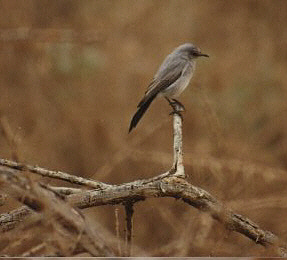 Blackstart.
Blackstart.
Andrew went for swim over the coral reef in the afternoon; Ricky and I were left to indulge in some serious shopping but not before a quick look in the Shulamit Park where Olivaceous Warbler, Black Bush Chat, Cretzschmar's Bunting, Black-headed and Ashy-headed Wagtail, Tree Pipit and Bluethroat were seen.
A quick check of the salt pans late afternoon produced nothing, but on the way back to the beach Andrew spotted a group of 26 Black Stork arriving off the sea. We paused for a short period to watch Pied Kingfisher and two Caspian Tern at the New Lake. The day concluded with our old favourite the Great Black-headed Gull, this time the 1st year.
March
23
The day started well with two Cretschzmar’s Buntings in the Shulamit Park.
Two Bluethroats fed in the open (why do they do this abroad but not in Britain?).
A classic male feldegg Black-headed Wagtail was accompanied by some more varied
individuals with olive backs, one with a white supercilium another with a
brown back……… It seemed little had arrived over night with the exception of
Reed, two Sedge and four Olivaceous Warblers. The Black Bush Chat was becoming
more difficult to keep up with but was a little easier to identify than a
stringy Menetrie’s Warbler claimed. Two large raptors got me excited as they
disappeared behind the hotels. When they came out the other side they proved
to be the pair of Bonelli’s Eagle. A Barbary Falcon mobbed them for a while
before disappearing into the mountains. While waiting for a taxi (something
that doesn’t take to long in Eilat, there’s loads of ‘em) we watched a pair
of Rock Martins prospecting for a nesting site in the eaves of a hotel.
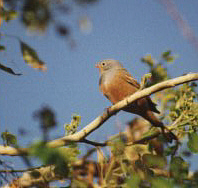 Cretschzmar’s
Bunting.
Cretschzmar’s
Bunting.
We decided to get a taxi to the cemetery where the target species was House Bunting. At first the driver was uncertain about our destination, we knew we were on the same wavelength when he asked, “what where the dead people are?” In the end we failed to find the Buntings but were latter told no-one had seen them recently. Ample compensation came on an area of waste ground at the end of the cemetery where we watched a female Blue Rock Thrush bashing the living daylights out of a large grasshopper. Every now and again the odd raptor was seen. First an Egyptian Vulture then three Steppe Buzzard and finally large shadow moving towards us on the rock belonged to a Short-toed Eagle. A strange call led us to a Sand Partridge further up the mountain. From here we walked to the pumping station seeing Black Kite, Chiffchaff, Bonelli's and Sedge Warbler in a Wadi en route.
Once at the Pumping Station we learned to our disappointment that we had missed the pair of Verreaux’s Eagles by half an hour. Numerous Chiffchaff and Eastern Bonelli’s Warblers frequented the bushes at the pumping station. The stars of the show were several mind-blowing male Ruppell’s Warblers, what a bird. While watching a group of Greenfinches a Masked Shrike appeared close by while three Desert Larks did their best to avoid our attention as they ran around on the rock face. Blackstarts are very good value and have an intriguing behavioural characteristic involving the fanning of one wing and the corresponding half of the tail simultaneously. Another potential tick was seen here in the guise of a Pallid Harrier. Being nothing more than a grey dot with black wing tips, it could be said it was out of this world, literally.
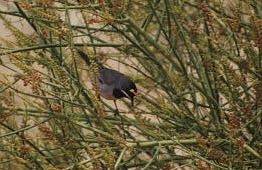 Ruppell’s
Warbler.
Ruppell’s
Warbler.
At the
New Reserve ever presents were three Water and four Red-throated Pipits. It
was disappointing that none of the red-throats lived up to their names although
it was good experience to hear the characteristic high pitch ‘speeeh’ flight
call. At the North Beach nine enigmatic White-eyed Gulls were seen along with
two Western Reef Herons.
March
24
A pre-breakfast sojourn in the Park produced Tree Pipit, Cretschzmar’s Bunting,
Black-headed Wagtail, Reed Warbler, Bluethroat, Redstart, Ruppell’s Warbler,
Tristram’s Grackle, Wryneck, Sedge Warbler, a good total of seven Olivaceous
Warblers and our old favourite the Black Bush Chat.
As this was our last day, time was at a premium so we didn’t venture too far.
Switzerland Park is within walking distance from the hotel and is an area
well worth a look. Unfortunately we missed the best birds during the week
from hearing about them too late in the day, they were White-tailed Plover
and Blue-checked Bee-eaters. Loads of Red-rumped Swallows were seen along
the canal. Having just seen a stunning Pied Kingfisher a Black-eared Wheatear
flew across the path and promptly disappeared out of view. A Desert Finch
was also seen briefly. A flock of 100 Steppe Buzzards was a very welcome sight
if not frustrating as we knew we only had a couple of hours left and it seemed
as though today was going to be good for raptors. Other goodies picked out
amongst the Buzzards were 3 Steppe Eagles, numerous Black Kites, Booted Eagle,
Barbary Falcon and a sublime male Pallid Harrier. At the park itself Bluethroat,
Chiffchaff and Spur-winged Plover were seen. We nearly missed an impressive
flock of swifts that contained 50+ Alpine, 20 Common Swift and 3 Pallid. The
only snakes of the trip were in the talons of the local Short-toed Eagles
of which two were seen that morning. At the New Lagoon a further 15 Alpine
Swifts were seen along with the ever present Red-throated, Tree and Water
Pipits.
We actually saw the Brown Booby do something it did fly although it was very distant and was a bit of a Southwold special. In flight it looked like a Gannet flying like a Manx Shearwater. Fifty Slender-billed Gulls, Little Egret and Great Black-headed Gull completed the picture.
On the way to Ovda airport we saw a Black-eared Wheatear and the last bird of the trip was a Crested Lark scampering about on the runway underneath our plane.
Other holiday reports:
Report on a birding holiday to High Island, Texas in Spring 1998 - with photographs
Report of a birding holiday to Beidaihe, China in May 1997 - with photographs